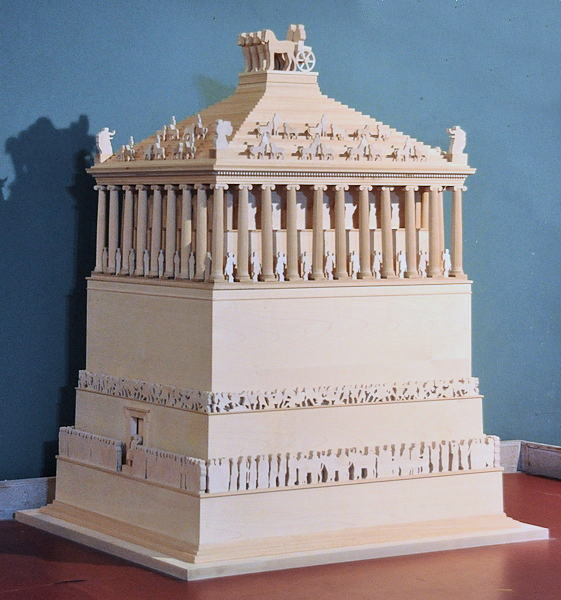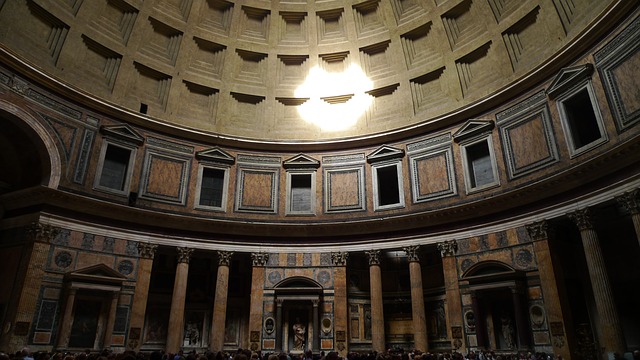Mausoleum

|
| This model represents the Mausoleum at Halicarnassus (near modern-day Bodrum, Turkey). The original structure was destroyed by several earthquakes during the 12th to the 15th centuries. Photo by Jona Lendering, Wikimedia Commons. |
Contents |
[edit] Introduction
A mausoleum is a building containing a stately type of tomb or a room for a tomb. The structure, typically made from stone, is freestanding and acts as an above ground burial chamber for the remains of one person or several people.
In English, the plural, mausoleums and mausolea, are both used.
[edit] History
The term mausoleum originated with the tomb of Mausolus at Halicarnassus, which was considered by Antipater of Sidon as one of the Seven Wonders of the Ancient World. This structure was built between 353 and 350 BC for Mausolus and his spouse, Artemisia (who was also his sister). Artemisia ordered the construction of the shrine for her husband and was interred in the mausoleum with him when she died.
Up until the widespread adoption of Christianity, large mausoleums were constructed for important people or leaders while smaller structures were used by the upper classes. After the rise of Christianity, this method of burial fell out of fashion for hundreds of years, but mausoleums became popular again in early modern times.
In areas susceptible to flooding, such as the American city of New Orleans, Louisiana, the above ground configuration of a mausoleum is considered a more practical burial option. Since it is possible to stack graves within a mausoleum, they are sometimes used in densely populated areas where available land is limited.
[edit] Modern mausoleums
A mausoleum encloses a burial chamber either wholly above ground or within a burial vault below the superstructure. Within the mausoleum is a crypt, which serves as both a memorial to the deceased and a container for the person’s remains.
There are several types of mausoleums
- Public mausoleums for multiple individuals (sometimes hundreds).
- Private (or custom) mausoleums exclusively for families.
- Garden mausoleums situated outdoors.
- Sarcophagus mausoleums which are partially above ground and partially below.
- Vestibule mausoleums designed to look like small houses.
Famous examples of mausoleums include:
Taj Mahal at Agra, India
Pantheon, Rome in Italy
Les Invalides in France
[edit] Related articles on Designing Buildings
Featured articles and news
RTPI leader to become new CIOB Chief Executive Officer
Dr Victoria Hills MRTPI, FICE to take over after Caroline Gumble’s departure.
Social and affordable housing, a long term plan for delivery
The “Delivering a Decade of Renewal for Social and Affordable Housing” strategy sets out future path.
A change to adoptive architecture
Effects of global weather warming on architectural detailing, material choice and human interaction.
The proposed publicly owned and backed subsidiary of Homes England, to facilitate new homes.
How big is the problem and what can we do to mitigate the effects?
Overheating guidance and tools for building designers
A number of cool guides to help with the heat.
The UK's Modern Industrial Strategy: A 10 year plan
Previous consultation criticism, current key elements and general support with some persisting reservations.
Building Safety Regulator reforms
New roles, new staff and a new fast track service pave the way for a single construction regulator.
Architectural Technologist CPDs and Communications
CIAT CPD… and how you can do it!
Cooling centres and cool spaces
Managing extreme heat in cities by directing the public to places for heat stress relief and water sources.
Winter gardens: A brief history and warm variations
Extending the season with glass in different forms and terms.
Restoring Great Yarmouth's Winter Gardens
Transforming one of the least sustainable constructions imaginable.
Construction Skills Mission Board launch sector drive
Newly formed government and industry collaboration set strategy for recruiting an additional 100,000 construction workers a year.
New Architects Code comes into effect in September 2025
ARB Architects Code of Conduct and Practice available with ongoing consultation regarding guidance.
Welsh Skills Body (Medr) launches ambitious plan
The new skills body brings together funding and regulation of tertiary education and research for the devolved nation.
Paul Gandy FCIOB announced as next CIOB President
Former Tilbury Douglas CEO takes helm.
UK Infrastructure: A 10 Year Strategy. In brief with reactions
With the National Infrastructure and Service Transformation Authority (NISTA).

























